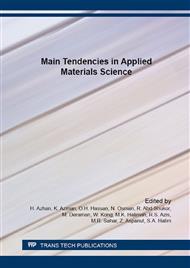p.189
p.193
p.199
p.205
p.210
p.216
p.225
p.230
p.237
Ba0.5Sr0.5Co0.8Fe0.2O3-δ (BSCF) Perovskite Nanorods by Template Synthesis
Abstract:
Ba0.5Sr0.5Co0.8Fe0.2O3-δ (BSCF) is a ceramic perovskite-type oxide that has attracted growing attention due to its high catalytic activity, mixed ionic/electronic conductivity and giant magnetic resistance. Improvement in the properties of BSCF can be achieved by tailoring its architecture such as nanoparticles (powdered form), nanotubes or nanorods as these nanostructured materials posses high surface-to-volume ratios with high sensitivity to surface adsorption and reactions. However, most of the studies conducted by means of conventional solid-state reaction methods or with wet chemistry techniques regularly produced BSCF in loose powdered form, non-uniform and the particle size is hard to be controlled. Herein in this work, an investigation on a synthetic approach using highly ordered nanoporous anodic aluminium oxide (AAO) as a template, focusing on the fabrication of BSCF perovskite nanorods is demonstrated. Sol-gel method is used to prepare the BSCF precursor solution or sol followed by filling the AAO template with the sol at different immersion time of 1 hr, 12 hrs and 24 hrs. After the following drying and calcination steps, the morphological structure and composition of the synthesized BSCF nanorods inside the AAO templates are examined by field emission scanning electron microscopy (FESEM) and energy dispersive X-ray (EDX) analysis. The micrograph showed BSCF nanorods are successfully synthesized at immersion time of 24 hrs with the diameter of nanorods embedded in the AAO template is approximately 180 nm. The EDX analysis also confirmed the stoichiometry of Ba0.5Sr0.5Co0.8Fe0.2O3-δ. Possible formation mechanism of BSCF nanorods inside the AAO template is also discussed in this paper.
Info:
Periodical:
Pages:
210-215
Citation:
Online since:
March 2016
Price:
Сopyright:
© 2016 Trans Tech Publications Ltd. All Rights Reserved
Share:
Citation:


